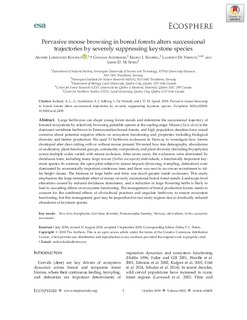| dc.contributor.author | Kolstad, Anders Lorentzen | |
| dc.contributor.author | Austrheim, Gunnar | |
| dc.contributor.author | Solberg, Erling Johan | |
| dc.contributor.author | De Vriendt, Laurent | |
| dc.contributor.author | Speed, James David Mervyn | |
| dc.date.accessioned | 2018-10-16T08:35:44Z | |
| dc.date.available | 2018-10-16T08:35:44Z | |
| dc.date.created | 2018-10-15T15:50:18Z | |
| dc.date.issued | 2018 | |
| dc.identifier.issn | 2150-8925 | |
| dc.identifier.uri | http://hdl.handle.net/11250/2568150 | |
| dc.description.abstract | Large herbivores can shape young forest stands and determine the successional trajectory of forested ecosystems by selectively browsing palatable species at the sapling stage. Moose (Alces alces) is the dominant vertebrate herbivore in Fennoscandian boreal forests, and high population densities have raised concerns about potential negative effects on ecosystem functioning and properties including biological diversity and timber production. We used 31 herbivore exclosures in Norway to investigate how forests developed after clear-cutting with or without moose present. We tested how tree demography, abundances of understory plant functional groups, community composition, and plant diversity (including bryophytes) across multiple scales varied with moose exclusion. After seven years, the exclosures were dominated by deciduous trees, including many large rowan (Sorbus aucuparia) individuals, a functionally important keystone species. In contrast, the open plots subject to moose impacts (browsing, trampling, defecation) were dominated by economically important coniferous trees and there was next to no rowan recruitment to taller height classes. The biomass of large herbs and ferns was much greater inside exclosures. This study emphasizes the large immediate effect of moose on early successional boreal forest stands. Landscape-level alterations caused by reduced deciduous dominance, and a reduction in large flowering herbs is likely to lead to cascading effects on ecosystem functioning. The management of boreal production forests needs to account for the combined effects of silvicultural practices and ungulate herbivory to ensure ecosystem functioning, but this management goal may be jeopardized in our study regions due to drastically reduced abundance of keystone species. Alces alces; bryophytes; Cervidae; diversity; Fennoscandia; forestry; Norway; silviculture; Sorbus aucuparia; succession. | nb_NO |
| dc.language.iso | eng | nb_NO |
| dc.publisher | Ecological Society of America | nb_NO |
| dc.rights | Navngivelse 4.0 Internasjonal | * |
| dc.rights.uri | http://creativecommons.org/licenses/by/4.0/deed.no | * |
| dc.title | Pervasive moose browsing in boreal forests alters successional trajectories by severely suppressing keystone species | nb_NO |
| dc.title.alternative | Pervasive moose browsing in boreal forests alters successional trajectories by severely suppressing keystone species | nb_NO |
| dc.type | Journal article | nb_NO |
| dc.type | Peer reviewed | nb_NO |
| dc.description.version | publishedVersion | nb_NO |
| dc.subject.nsi | VDP::Zoologiske og botaniske fag: 480 | nb_NO |
| dc.subject.nsi | VDP::Zoology and botany: 480 | nb_NO |
| dc.source.volume | 9 | nb_NO |
| dc.source.journal | Ecosphere | nb_NO |
| dc.source.issue | 10 | nb_NO |
| dc.identifier.doi | 10.1002/ecs2.2458 | |
| dc.identifier.cristin | 1620516 | |
| dc.description.localcode | © 2018 The Authors. This is an open access article under the terms of the Creative Commons Attribution License, which permits use, distribution and reproduction in any medium, provided the original work is properly cited. | nb_NO |
| cristin.unitcode | 194,31,10,0 | |
| cristin.unitname | Institutt for naturhistorie | |
| cristin.ispublished | true | |
| cristin.fulltext | original | |
| cristin.qualitycode | 1 | |

